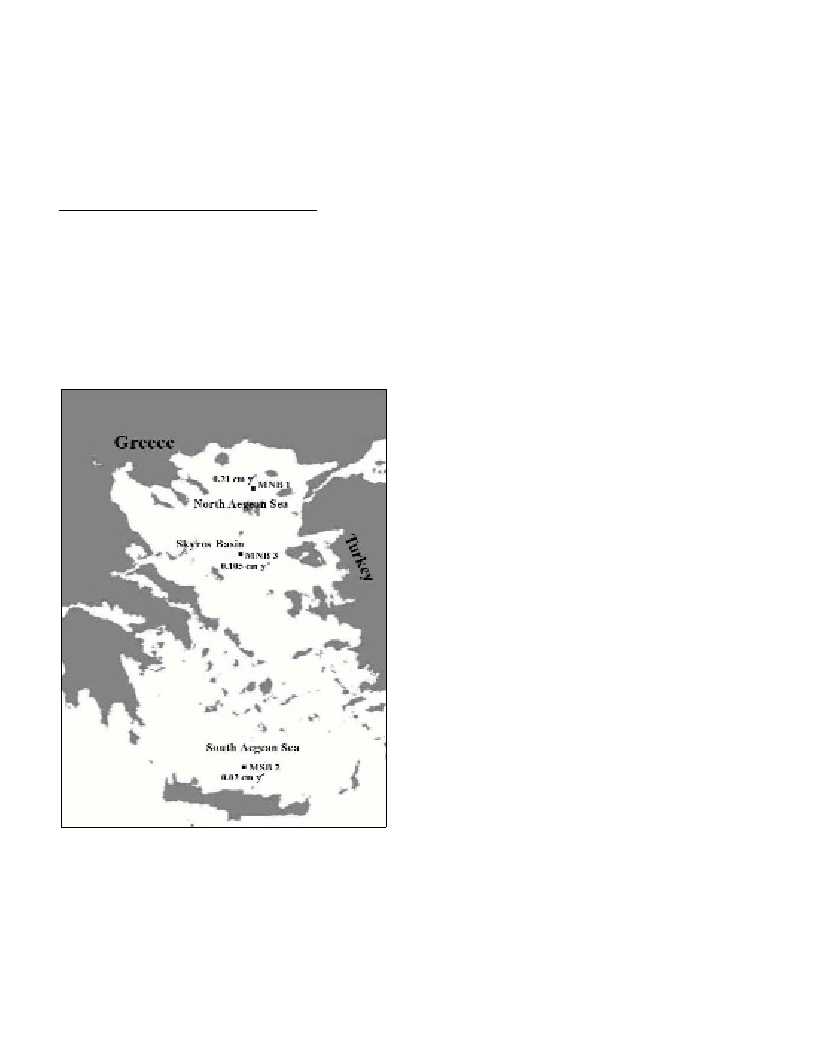RECENT SEDIMENTATION RATES IN THE AEGEAN SEA
H. Kaberi * and V. Lykousis
Hellenic Centre for Marine Research, Anavyssos, Greece
Abstract
Sedimentation rates were determined in three deep basins of the Aegean Sea, using the
210
Pb method. In the North Aegean basin the
sedimentation rate was the highest (0,21 cm y
-1
); in the Central Aegean Sea, the Skyros basin, the sedimentation rate was found lower than
the previous one (0,105 cm y
-1
); the lowest sedimentation rate was calculated in the South Aegean basin (0,02 cm y
-1
), where the main
sources of particles are the biological processes in the water column and the atmospheric fall-out.
Keywords: sedimentation rates,
210
Pb, Aegean Sea.
Rapp. Comm. int. Mer Médit., 37,2004
39
Sediment accumulation rates were determined in three basins of the
Aegean Sea in the framework of the MTP-II-MATER project. The
cores that were analyzed for
210
Pb were collected from the North
Aegean basin (MNB-1), the Skyros basin in the Central Aegean Sea
(MNB-3) and the South Aegean basin (MSB-2) (Fig.1). According to
Lykousis et al.(2002) there appears to be a N-S gradient in the
biogeochemical processes in the Aegean Sea. Moreover, in the North
Aegean mass ?uxes in the water column are characterized strongly by
the lithogenic constituent, due to the river discharge from the northern
mainland of Greece. In contrast, the South Aegean ?uxes appear to
depend more upon the biogenic component and less on the lithogenic
fall-out [1].
Sediment cores (
Ø
6cm and about 50cm long) were sub sampled
from a box corer, during the August 1997 cruise of the R/V Aegaeo.
For the total dissolution of the dry sediments the analytical method
described by Sanchez-Cabeza et al.[2] was followed.
210
Po isotopes
were deposited on silver discs and counted in both sides on a total
alpha-counter (Ortec EG&C) [3]. Sedimentation rates were calculated
assuming secular equilibrium between
210
Po and
210
Pb.
For the determination of the biomixing zone and the calculation of
the sedimentation rates the Biodiffusive Model was used [3, 4, 5]
according to which the biological process is given by the advection -
diffusion equation. The accumulation rate (S) is calculated in the zone
below the mixed layer whereas the mixing coefficient (D
B
) is
calculated within the mixing layer of the sediment core. It must be
noted that the rates calculated this way are the apparent one.
Supported
210
Pb concentrations were determined from the deeper
parts of the cores where the total
210
Pb concentrations were constant
with depth.
Core MNB-1 was collected from a depth of 1287 m in the deep
basin of the North Aegean Sea. The vertical profile of the unsupported
210
Pb activity showed a significant decrease below the 10-11 cm layer
of the sediment core. Surface
210
Pb activity was 34.5 dpm g
-1
. The
upper 4-4,5 cm of the core seemed to be mixed. The apparent
accumulation rate calculated according to the Biodiffusive model was
found to be 0,21 cm y
-1
and the mixing coefficient about 4.2 cm
2
y
-1
.
Core MNB-3 was taken from the Skyros basin (820 m) in the
Central Aegean Sea. The vertical profile of the unsupported
210
Pb
showed an almost theoretical exponential decrease until the 18 cm
depth, with a surface concentration of 40 dpm g
-1
. The sedimentation
rate was found 0.105 cm y
-1
, whereas, no mixing was observed in the
surface layer of the sediment core.
MSB-2 core was collected from a depth of about 1600 m, in the South
Aegean deep basin. Surface
210
Pb total activity was 13,9 dpm g
-1
,
lower enough than in surface sediments of the North Aegean Sea.
Below the first 0,5cm of the sediment core,
210
Pb activities decreased
very sharply. According to the Biodiffusive model, the apparent
sedimentation rate was found to be 0,02 cm y
-1
and the mixing
coefficient 0,022 cm
2
y
-1
.
Concluding, the most important finding of this work is the
quantification in a way of the previously demonstrated difference
between the three basins of the Aegean Sea as far as the sediment
supply is concerned.
References
1-Lykousis V., G. Chronis, A. Tselepides, N.B. Price, A. Theocharis, I.
Siokou-Frangou, F. Van Wambeke, R. Danovaro, S. Stavrakakis, G.
Duineveld, D. Georgopoulos, L. Ignatiades, A. Souvermezoglou, F.
Voutsinou-Taliadouri, 2002. Major outputs of the recent multidisciplinary
biogeochemical researches undertaken in the Aegean Sea. Journal of
Marine Systems, 33-34: 313-334.
2-Sanchez-Cabeza, J.A., Masque, P. and Ani-Ragolta, I., 1998.
210
Pb and
210
Po analysis in sediments and soils by microwave acid digestion.
Journal of Radioactivity and Nuclear Chemistry, 227(1-2): 19-22.
3-Radakovitch O., 1995. Etude du transfert et du dépôt du matériel
particulaire par le
210
Po et le
210
Pb. Application aux marges continentales
du Golfe de Gascogne (NE Atlantique) et du Golfe du Lion (NW
Méditerranée). PhD. Thesis Univ. of Perpignan.
4-Nittrouer C.A., DeMaster D.J., McKee B.A., Cutshall N.H. and I.L.
Larsen, 1983/1984. The effect of sediment mixing on Pb-210
accumulation rates for the Washington continental shelf. Mar. Geol., 54:
201-221.
5-Guinasso N.L. and Schink D.R., 1975. Quantitative estimates of
biological mixing rate in abyssal sediments. Jour. Geophys. Res., 80:
3032-3043.

